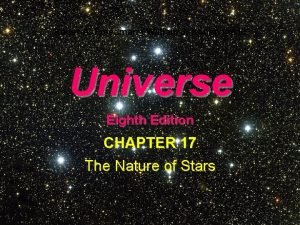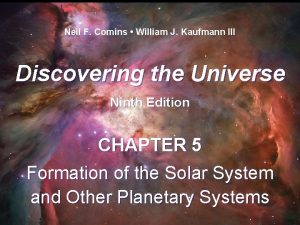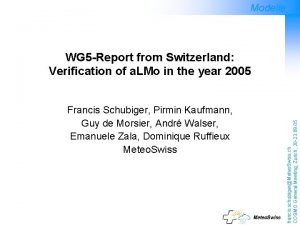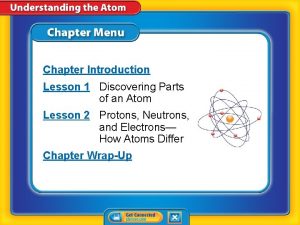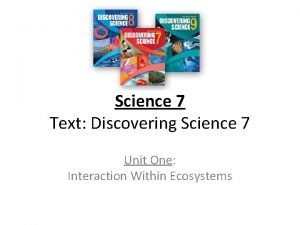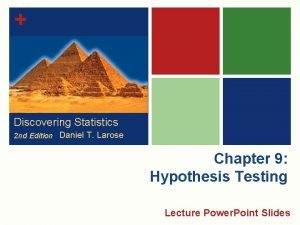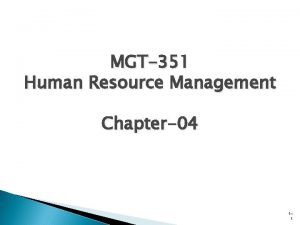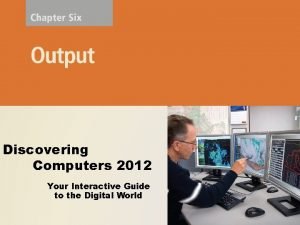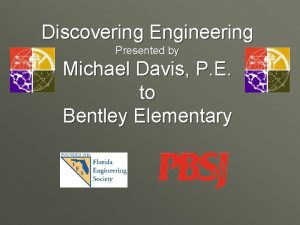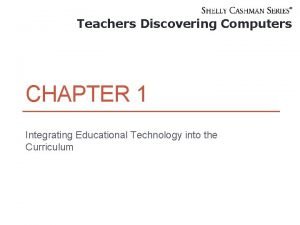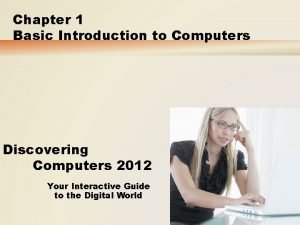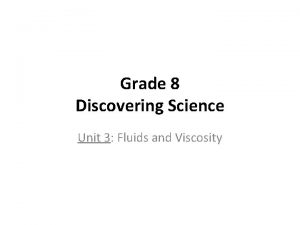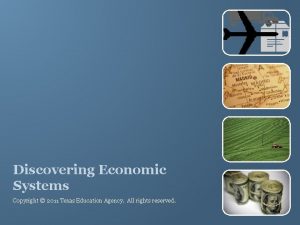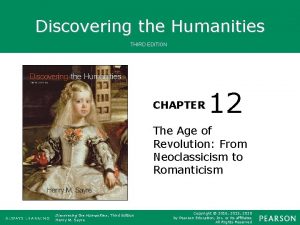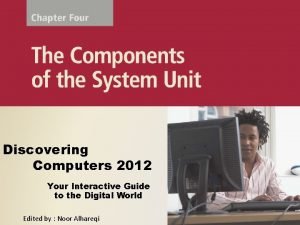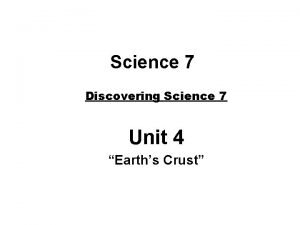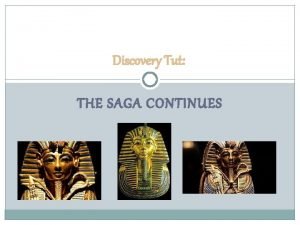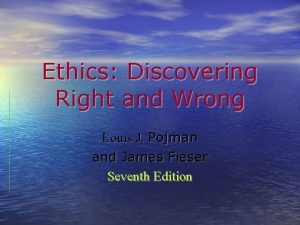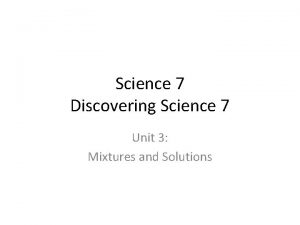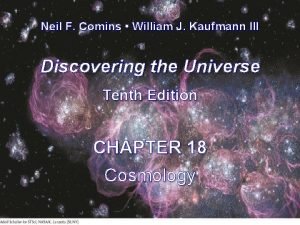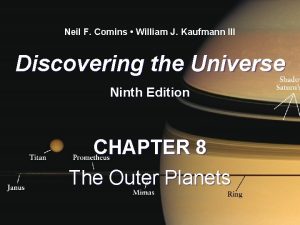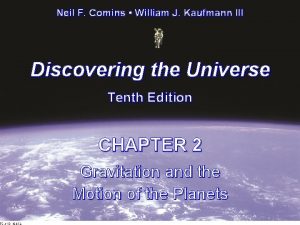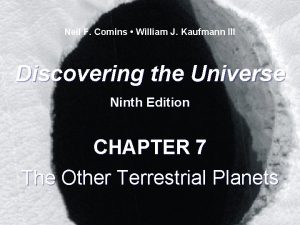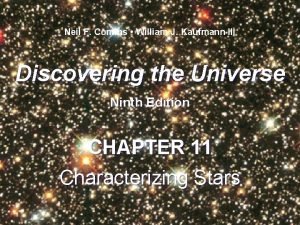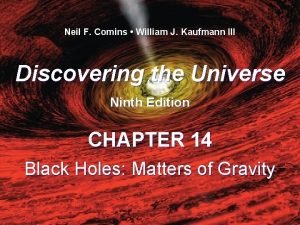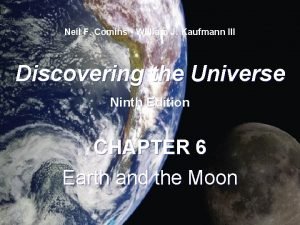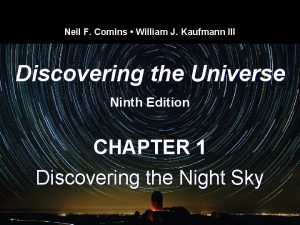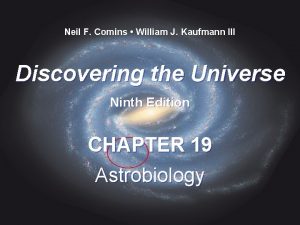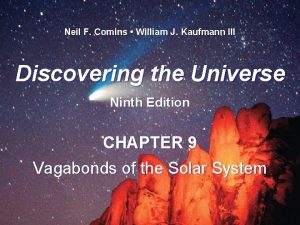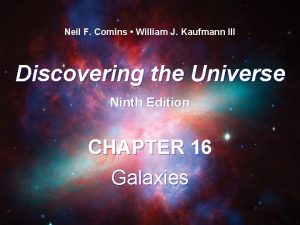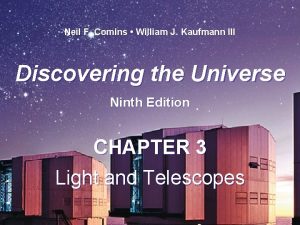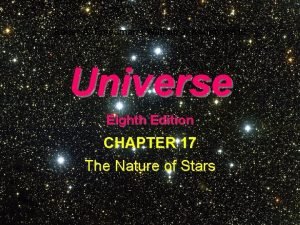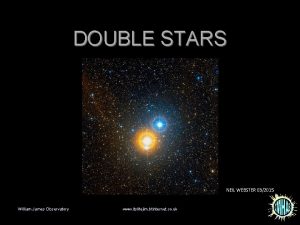Neil F Comins William J Kaufmann III Discovering







































- Slides: 39

Neil F. Comins • William J. Kaufmann III Discovering the Universe Ninth Edition CHAPTER 5 Formation of the Solar System and Other Planetary Systems

A montage of the planets in our solar system presented in correct relative sizes. The orbits in the background are also drawn to scale.



WHAT DO YOU THINK? 1. 2. 3. 4. 5. How many stars are there in the solar system? Were the Sun and planets among the first generation of objects created in the universe? How long has Earth existed, and how do we know this? What typical shape(s) do moons have, and why? Have any Earthlike planets been discovered orbiting Sunlike stars?

In this chapter you will discover… l l l l l how the solar system formed why the environment of the early solar system was much more violent than it is today how astronomers define the various types of objects in the solar system the relationships between planets, dwarf planets, small solar system bodies, and other classifications of objects in the solar system how the planets are grouped as they are how the moons formed throughout the solar system what the debris of the solar system is made of that disks of gas and dust, as well as planets, have been observed around a growing number of stars that newly forming stars and planetary systems are being discovered every year

How Stars Lose Mass Antares is nearing the end of its existence. Strong winds from its surface are expelling large quantities of gas and dust, creating this nebula. The “planetary nebula” Abell 39 exhibits a relatively gentle emission of matter; the central star shed its outer layers of gas and dust in an expanding spherical shell now about 6 ly across. The Crab Nebula: A supernova is the most powerful known mechanism for a star to shed mass.

Dusty Regions of Star Formation (a) These three bright young stars in the constellation Monoceros are still surrounded by much of the gas and dust from which they formed. This is a tiny part of a much larger cloud, known as the Cone Nebula. Astronomers hypothesize that the solar system formed from a similar fragment of an interstellar gas and dust cloud. (b) These are newly formed stars in the Orion Nebula. Although visible light from many of the stars is blocked by the nebula, their infrared emission travels through the gas and dust to us.

The Formation of the Solar System

Young Circumstellar Disks of Matter Orion Nebula with Hubble Space Telescope. The four insets: false-color images of protoplanetary disks within the nebula. A newborn star is at the center of each disk.

This computer simulation shows the formation of the inner planets over time.

The Nice Model and the Outer Solar System The outer planets formed much closer to the sun. Flinging material into the inner solar system caused them to spiral outward Later, they sent rocky and icy material out to the outer reaches of the solar system to stop their outward motion. This resulted in the formation of the Kuiper belt and Oort cloud.

Asteroid Gaspra, taken in 1991 by the Galileo spacecraft on its way to Jupiter. The asteroid measures 12 x 20 x 11 km. Millions of similar chunks of rock orbit the Sun between the orbits of Mars and Jupiter. Even smaller rocky bodies called meteoroids are scattered throughout the solar system.

Thousands of lunar craters were produced by impacts of leftover rocky debris from the formation of the solar system. Age-dating of lunar rocks brought back by the astronauts indicates that the Moon is about 4. 5 billion years old. Most of the lunar craters were formed during the Moon’s first 700 million years of existence.

Different Classifications of Solar System Objects Here are classifications of solar system objects. A planet is an object that 1) orbits the sun; 2) has enough mass so that its own gravitational attraction causes it to be essentially spherical; 3) has enough gravitational attraction to clear its neighborhood of other orbiting debris. A dwarf planets fulfills conditions (1) and (2), but not (3). A small solar system object only fulfills (1).

Planetary orbits around the Sun, to scale. All orbits are counterclockwise as viewed from above Earth’s North Pole. The orbits appear nearly circular, with Mercury having the most elliptical orbit. Edge view shows that all orbits are nearly in the ecliptic plane.

The Sun and the planets with size drawn to scale. The four planets that orbit nearest the Sun (Mercury, Venus, Earth, and Mars) are small and made of rock and metal. The next two planets (Jupiter and Saturn) are large and composed primarily of hydrogen and helium. Uranus and Neptune are intermediate in size and contain roughly equal amounts of ices, hydrogen and helium, and terrestrial material.

All of the objects in this image have the same mass (total number of particles). However, the chemicals from which they form have different densities (number of particles per volume), so they each take up different amounts of space (volume).

A Circumstellar Disk of Matter Hubble view of Beta Pictoris, with an edge-on disk of material 225 billion km (1500 AU) across that orbits the star 50 ly from Earth. Twenty million years old, this disk is believed to be composed primarily of icy bodies that orbit the star. The smaller disk is believed to have been formed by the gravitational pull of a roughly Jupiter-mass planet in that orbit.

Off-Center Disk The star Fomalhaut, blocked out, is surrounded by gas and dust in a ring whose center is separated from the star by 15 AU, nearly as far as Uranus is from the Sun. This offset is believed to be due to the gravitational effects of a giant planet orbiting Fomalhaut. This system is 25 ly from Earth. The dimmer debris in that system and between us and it scatters light that is considered “noise” in such images.

This infrared image of an almost-extrasolar planet was taken at the European Southern Observatory. Neither object is quite large nor massive enough to be a star, and evidence suggests that 2 M 1207 b did not form from a disk of gas and dust surrounding the larger body; hence, it is not a planet. This system is about 170 ly from the solar system.

Three Traditional Methods of Detecting Exoplanets (a) A planet and its star both orbit around their common center of mass, always staying on opposite sides of that point. The star’s motion around the center of mass provides astronomers with the information that a planet is present. (b) As a planet moves toward or away from us, its star moves in the opposite direction. Using spectroscopy, we can measure the Doppler shift of the star’s spectrum, which reveals the effects of the unseen planet or planets. (c) If a star and its planet are moving across the sky, the motion of the planet causes the star to orbit its center of mass. This motion appears as a wobbling of the star across the celestial sphere. (d) If a planet happens to move in a plane that takes it across its star (that is, the planet transits the star), as seen from Earth, then the planet will hide some of the starlight, causing the star to dim. This change in brightness will occur periodically and can reveal the presence of a planet.

This figure shows the separation between extrasolar planets and their stars. Note that many systems have giant planets that orbit much closer than 1 AU from their stars. (MJ is shorthand for the mass of Jupiter. ) For comparison, the solar system is shown at top.

Microlensing Reveals an Extrasolar Planet Gravitational fields cause light to change direction. The deflection itself is too small to be detectable, but it does increase detectably the apparent brightness of the distant star. A planet makes it non-syymetric.

A Star with Three Planets The star Upsilon Andromedae has at least three planets, discovered by measuring the complex Doppler shift of the star. This star system is located 44 ly from Earth, and the planets all have masses similar to Jupiter’s. (b) The orbital paths of the planets, labeled B, C, and D, along with the orbits of Venus, Earth, and Mars, are drawn for comparison.

Summary of Key Ideas

Formation of the Solar System l l Hydrogen, helium, and traces of lithium, the three lightest elements, were formed shortly after the formation of the universe. The heavier elements were produced much later by stars and are cast into space when stars die. By mass, 98% of the observed matter in the universe is hydrogen and helium. The solar system formed 4. 6 billion years ago from a swirling, disk-shaped cloud of gas, ice, and dust called the solar nebula. The planets and other debris in the solar system today formed from gas, ice, and dust in the solar nebula orbiting the protosun. The outer solar system, beyond the snow line, had both dust and ice (including hydrogen and helium), while inside the snow line, such ices were vaporized by the protosun.

Formation of the Solar System l l Jupiter and Saturn were initially worlds of rock and metal that pulled onto themselves large amounts of hydrogen and helium, along with some water. Uranus and Neptune were also initially worlds of rock and metal, but they attracted more water and less hydrogen and helium than the other giant planets. The Nice model of solar system formation proposes that in the outer solar system, Jupiter formed first, followed by Saturn, and then by Neptune and Uranus, which were flung out to their present orbits by gravitational forces from Jupiter and Saturn. The four inner planets formed through the collisions of Moon-sized bodies, probably after the outer four planets were formed.

Formation of the Solar System l l The Sun formed at the center of the solar nebula. After about 100 million years, the temperature at the protosun’s center was high enough to ignite thermonuclear fusion reactions. For 800 million years after the Sun formed, impacts of asteroidike objects on the young planets dominated the history of the solar system.

Categories of Solar System Objects l l l Astronomical objects smaller than the eight planets are classified as dwarf planets or small solar system bodies (SSSBs). A variety of other names, including asteroids, comets, meteoroids, trans-Neptunian objects, plutinos, plutoids, Kuiper belt objects (KBOs), and Oort cloud objects, overlap with the designations “dwarf planet” and “SSSB”. KBOs and Oort cloud objects are trans-Neptunian objects—they orbit farther from the Sun than the outermost planet. To date, five objects—Pluto, Ceres, Eris, Haumea, and Makemake—have been classified as dwarf planets. Other objects orbit the Sun beyond Neptune. At least 1500 KBOs have been observed. A few potential Oort cloud objects have also been identified.

Comparative Planetology l l l The four inner planets of the solar system share many characteristics and are distinctly different from the four giant outer planets. The four inner, terrestrial planets are relatively small, have high average densities, and are composed primarily of rock and metal. Jupiter and Saturn have large diameters and low densities and are composed primarily of hydrogen and helium. Uranus and Neptune have large quantities of water as well as much hydrogen and helium.

Comparative Planetology l l Pluto, once considered the smallest planet, has a size, density, and composition consistent with other large Kuiper belt objects (KBOs). Asteroids are rocky and metallic debris in the solar system, are larger than about 10 m in diameter, and are found primarily between the orbits of Mars and Jupiter. Meteoroids are smaller pieces of such debris. Comets are debris that contain both ice and rock.

Planets Outside Our Solar System l l Astronomers have observed disks of gas and dust orbiting young stars. At least 506 exoplanets have been discovered orbiting other stars. Most of the exoplanets that have been discovered have masses roughly equal to the mass of Jupiter. Exoplanets are discovered indirectly as a result of their effects on the stars they orbit.

Key Terms accretion albedo asteroid belt average density comet crater dense core dwarf planet Jeans instability Kuiper belt object (KBO) meteoroid metals microlensing moon (natural satellite) Nice model Oort cloud orbital inclination planetesimal protoplanetary disks (proplyds) protosun small solar system body (SSSB) solar nebula solar system terrestrial planet trans-Neptunian object (TNO)

WHAT DID YOU THINK? l l How many stars are there in the solar system? One, the Sun.

WHAT DID YOU THINK? l l Were the Sun and planets among the first generation of objects created in the universe? No. All matter and energy were created by the Big Bang. However, much of the material that exists in our solar system was processed inside stars that evolved before the solar system existed. The solar system formed billions of years after the Big Bang occurred.

WHAT DID YOU THINK? l l How long has Earth existed, and how do we know this? Earth formed along with the rest of the solar system, about 4. 6 billion years ago. The age is determined from the amount of radioactive decay that has occurred in it.

WHAT DID YOU THINK? l l What typical shape(s) do moons have, and why? Although some moons are spherical, most look roughly like potatoes. Those that are spherical are held together by the force of gravity, which pulls down high regions. Those that are potato-shaped are held together by the electromagnetic interaction between atoms, just like rocks. These latter moons are too small to be reshaped by gravity.

WHAT DID YOU THINK? l l Have any Earthlike planets been discovered orbiting Sunlike stars? Not really. Most exoplanets are Jupiterlike gas giants. The planets similar in mass and size to Earth are either orbiting remnants of stars that exploded or, in the case of Gliese 581, a star much less massive and much cooler than the Sun.
 Neil comins
Neil comins Neil comins
Neil comins Hamlet act iii scene ii
Hamlet act iii scene ii Qumica
Qumica Pirmin kaufmann
Pirmin kaufmann Kaufmann diet phase 1
Kaufmann diet phase 1 Cathy kaufmann
Cathy kaufmann Ahk london
Ahk london Philippe spitaleri kaufmann
Philippe spitaleri kaufmann Rahmenlehrplan bürokaufmann
Rahmenlehrplan bürokaufmann Camp emma kaufmann
Camp emma kaufmann Eric kaufmann birkbeck
Eric kaufmann birkbeck Philippe spitaleri kaufmann
Philippe spitaleri kaufmann Kaufmann
Kaufmann Kaufmann im e-commerce report
Kaufmann im e-commerce report William henry gates iii was born on 28 october 1955
William henry gates iii was born on 28 october 1955 Chapter 7 lesson 1 discovering parts of an atom answer key
Chapter 7 lesson 1 discovering parts of an atom answer key Discovering science 7
Discovering science 7 P test in statistics
P test in statistics Participant diary/logs
Participant diary/logs Tactile output devices
Tactile output devices Discovering engineering
Discovering engineering Discovering computers 2018 chapter 1
Discovering computers 2018 chapter 1 Discovering computer
Discovering computer Discovering the internet
Discovering the internet Grade 8 science unit 3
Grade 8 science unit 3 Discovering economic systems guided practice
Discovering economic systems guided practice Benjamin latrobe
Benjamin latrobe The system generates regular electronic pulses
The system generates regular electronic pulses Defining and debating america's founding ideals
Defining and debating america's founding ideals Rock vs mineral
Rock vs mineral Self motivation meaning
Self motivation meaning Discovering cells
Discovering cells Ar williams author of discovering tut
Ar williams author of discovering tut Discovering computers 2011
Discovering computers 2011 Discovering computers 2018 ppt download
Discovering computers 2018 ppt download Ethics discovering right and wrong
Ethics discovering right and wrong Teachers discovering computers
Teachers discovering computers Muhamed computer technology
Muhamed computer technology Discovering science 7
Discovering science 7
